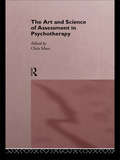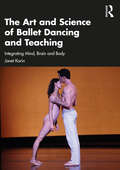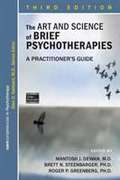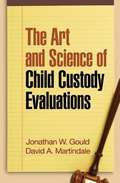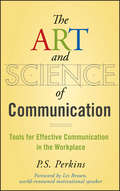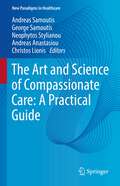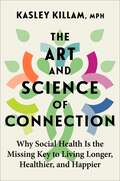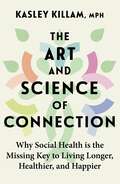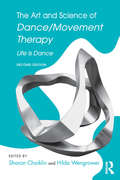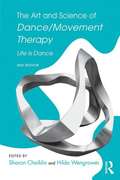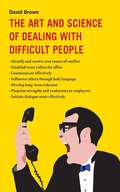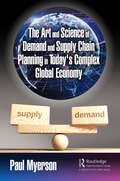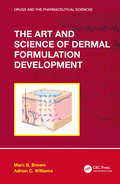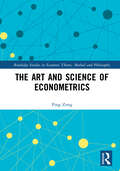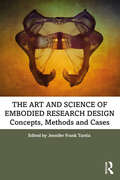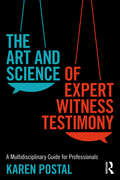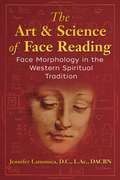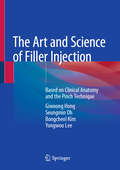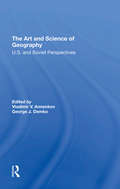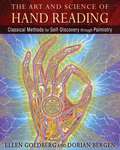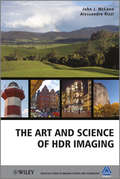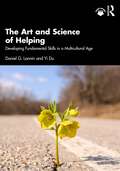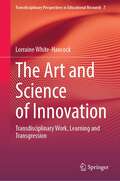- Table View
- List View
The Art and Science of Assessment in Psychotherapy
by Chris MaceWhile professional trainings in psychotherapy and counselling vary considerably in the attention they pay to assessment, courses, conferences and workshops devoted to the subject are attracting an audience eager for more demonstration and discussion. In response, The Art and Science of Assessment in Psychotherapy offers an extended symposium on principles and practice. Guided by a belief that comparative study will spur critical reflection and innovation, its presentations encompass a wide range of therapeutic orientations, settings and interests. In the book twelve distinguished practitioners of widely used approaches within psychotherapy describe the methods they use in their assessments and how these have developed. They also discuss the uses and limitations of the therapies they offer. The approaches covered include psychoanalytic psychotherapy, in-patient psychotherapy, family therapy, group psychotherapy, psychodrama, cognitive-behaviour therapy, couple therapy and focal therapy. Additional chapters look at assessment in the light of psychotherapy research, question how far assessment can be separated from treatment, and ask whether the use of questionnaires and special tests aids or detracts from interviewing as a method of assessment. As psychotherapy matures as a profession, both chronologically and in response to public demand, interest in assessment methods is growing, yet to date the published material has been limited and dispersed amongst specialist books and journals. The Art and Science of Assessment in Psychotherapy offer the first comprehensive, practical review of a key professional issue which will be of interest to all practising psychotherapists and counsellors.
The Art and Science of Ballet Dancing and Teaching: Integrating Mind, Brain and Body
by Janet KarinThis book offers an inside view of ballet as the art form we see on stages today, detailing how expressive movement is initiated and controlled, and discussing the importance of embedding creativity and expressivity within ballet technique from the dancer’s first lesson to their final performance. Janet Karin O.A.M. promotes ballet as a holistic art form resulting from the integration of mind, brain and body, and describes the motor control factors that can enhance or interfere with achievement. Throughout, professional dancers’ personal experiences illuminate the text, from the euphoria of ‘flow’ to the search for creativity and harmony, from the debilitating effects of anxiety, trauma and pain to the reward of artistic autonomy. Teaching is presented from a philosophical viewpoint, enriching and extending the child’s innate movement skills and expressive power. Practical yet reflective, this is an essential guide for dancers as well as dance educators and students.
The Art and Science of Brand Valuation
by Jill AveryIndustry and Background Note - Brand valuation, the art and science of calculating the economic value accruing to a firm from its use on an intangible brand asset, yields frustratingly inconsistent, discrepant, and therefore, controversial results. While it is widely accepted that brands are long-lived assets that can contribute significant value to firms over time, there is no consensus on how to value them. This note outlines several different methods for valuing brands and exposes readers to the commercial methods most used by firms. It discusses the opportunities associated with valuing brands as well as the challenges.
The Art and Science of Brief Psychotherapies: A Practitioner's Guide
by Mantosh J. Dewan Brett N. Steenbarger Roger P. GreenbergWith all of the expert-authored content that made previous editions indispensable references for students and practitioners alike, this third edition of The Art and Science of Brief Psychotherapies: A Practitioner's Guide has been updated to reflect this rapidly changing field. Most chapters include new material that documents recent developments within existing models, and new chapters tackle topics that include the following: * Multicultural practice* Mentalizing* Motivational interviewing* Dialectical behavior therapy* Telepsychiatry* Internet-based interventions All chapters summarize the ideas underlying each modality, the evidence for effectiveness, and the techniques and interventions central to each. In a national and global environment of limited economic resources and multiple demands on patients' time, short-term treatment modalities are increasingly important. Integrating theory, research, and step-by-step procedures, The Art and Science of Brief Psychotherapies is an ideal introduction to the range of short-term therapies for psychiatry residents, psychology interns, social work students, and experienced practitioners looking to broaden their practice.
Art and Science of Child Custody Evaluations
by David Martindale Jonathan GouldAddressing key topics in child custody evaluation, this book provides essential knowledge for practitioners who want to meet the highest standards for both scientific validity and legal admissibility. The authors are leading experts who describe the latest data-based approaches to understanding and assessing relevant child, parent, and family factors. Going beyond the basics, the book gives in-depth attention to challenging, frequently encountered issues, such as how to evaluate allegations of domestic violence, child sexual abuse, and child alienation. Also covered are the complexities of interviewing children effectively and working in the adversarial forensic context. A user-friendly appendix contains sample letters and statements of understanding, with permission to photocopy.
The Art and Science of Communication
by Les Brown P. S. PerkinsThe Art and Science of Communication shows you a new way to understand and use communication in the workplace. Revealing the seven types of communication we all use every day, the book shows you how to increase your communication effectiveness in any setting with practical techniques, analogies, and models that clearly explain the formulas for successful communication. Combining the science and art of communication into one effective formula, this book offers a straightforward and easy to understand plan for a more successful career.
The Art and Science of Compassionate Care: A Practical Guide (New Paradigms in Healthcare)
by Andreas Samoutis George Samoutis Neophytos Stylianou Andreas Anastasiou Christos LionisThis book provides a practical guide on the art and science of compassionate care in an era of healthcare crisis due to the COVID-19 pandemic that is inflicting long-lasting financial and psychosocial trauma on an unprecedented scale. A new approach to compassionate care is presented based on the overarching concepts of empathy, person and family centeredness, therapeutic relationship, kindness, gratitude, spirituality, communication skills, shared decision making, positive psychology, adversity-activated development, self-care, compassion fatigue, spirituality which are more than ever critical in successfully managing the pandemic adversity in front of us. This book draws on clinical experience, educational activities and evidence-based knowledge from academic physicians (primary, secondary and tertiary care), nurses, psychologists, health economists, healthcare managers, health policymakers, medical professionals students and patients. It provides skills and knowledge that can be implemented in daily clinical practice based on all levels of healthcare on a whole-person approach. An array of clinical cases, patient journeys, published evidence and practical experience is combined to deliver in a practical way unique guidance and advice. The target audience is all healthcare professionals, health policymakers, healthcare managers and patient associations. This approach of Compassionate Care is of great importance and can save lives and money in these unprecedented times of global healthcare care system challenges.
The Art and Science of Connection: Why Social Health Is the Missing Key to Living Longer, Healthier, and Happier
by Kasley KillamA groundbreaking redefinition of what it means to be healthy that introduces the need for social health—the part of wellbeing that comes from feeling connected—to truly flourish.Exercise. Eat a balanced diet. Go to therapy. Most wellness advice is focused on achieving and maintaining good physical and mental health. But Harvard-trained social scientist and pioneering social health expert Kasley Killam reveals that this approach is missing a vital component: human connection. Relationships not only make us happier, but also are critical to our overall health and longevity. Research shows that people with a strong sense of belonging are 2.6 times more likely to report good or excellent health. Perhaps even more astonishingly, people who lack social support are up to 53% more likely to die from any cause. Yet social health has been overlooked and underappreciated—until now.Just as we exercise our physical muscles, we can strengthen our social muscles. Weaving together cutting-edge science, mindset shifts, and practical wisdom, Killam offers the first methodology for how to be socially healthy. An antidote to the loneliness epidemic and an inspiring manifesto for seeing wellbeing as not only physical and mental, but also social, The Art and Science of Connection is a handbook for thriving. In this essential book, you will:Learn a simple yet powerful framework to understand, evaluate, and bolster your social health.Discover the exact strategy or habit you need, as well as research-backed tips, to cultivate and sustain meaningful connection now and throughout your life.Glean actionable insights to develop a sense of community in your neighborhood, at work, and online from a spirited group of neighbors in Paris, the CEO of a major healthcare company, and an artificially intelligent chatbot.Get an insider look at the innovative ways that doctors, teachers, entrepreneurs, architects, government leaders, and everyday people are catalyzing a movement toward a more socially healthy society.The Art and Science of Connection will transform the way you think about each interaction with a friend, family member, coworker, or neighbor, and give you the tools you need to live a more connected and healthy life—whether you are an introvert or extrovert, if you feel stretched thin, and no matter your age or background. Along the way, Killam will reveal how a university student, a newlywed, a working professional, and a retired widow overcame challenges to thrive through connection—and how you can, too.
The Art and Science of Connection: Why Social Health is the Missing Key to Living Longer, Healthier, and Happier
by Kasley KillamA groundbreaking redefinition of what it means to be healthy that introduces the need for social health - the part of wellbeing that comes from feeling connected - to truly flourish.Exercise. Eat a balanced diet. Go to therapy. Most wellness advice is focused on achieving and maintaining good physical and mental health. But Harvard-trained social scientist and pioneering social health expert Kasley Killam reveals that this approach is missing a vital component: human connection.Relationships not only make us happier, but also are critical to our overall health and longevity. Research shows that people with a strong sense of belonging are 2.6 times more likely to report good or excellent health. Perhaps even more astonishingly, people who lack social support are up to 53% more likely to die from any cause. Yet social health has been overlooked and underappreciated - until now.Just as we exercise our physical muscles, we can strengthen our social muscles. Weaving together cutting-edge science, mindset shifts, and practical wisdom, Killam offers the first methodology for how to be socially healthy. An antidote to the loneliness epidemic and an inspiring manifesto for seeing wellbeing as not only physical and mental, but also social, The Art and Science of Connection is a handbook for thriving.In this essential book, you will:- Learn a simple yet powerful framework to understand, evaluate, and bolster your social health.- Discover the exact strategy or habit you need, as well as research-backed tips, to cultivate and sustain meaningful connection now and throughout your life.- Glean actionable insights to develop a sense of community in your neighbourhood, at work, and online from a spirited group of neighbours in Paris, the CEO of a major healthcare company, and an artificially intelligent chatbot.- Get an insider look at the innovative ways that doctors, teachers, entrepreneurs, architects, government leaders, and everyday people are catalysing a movement toward a more socially healthy society.The Art and Science of Connection will transform the way you think about each interaction with a friend, family member, coworker, or neighbour, and give you the tools you need to live a more connected and healthy life - whether you are an introvert or extrovert, if you feel stretched thin, and no matter your age or background. Along the way, Killam will reveal how a university student, a newlywed, a working professional, and a retired widow overcame challenges to thrive through connection-and how you can, too.
The Art and Science of Dance/Movement Therapy: Life Is Dance
by Hilda Wengrower Sharon ChaiklinThe Art and Science of Dance/Movement Therapy offers both a broad understanding and an in-depth view of how and where dance therapy can be used to produce change. The chapters go beyond the basics that characterize much of the literature on dance/movement therapy, and each of the topics covered offers a theoretical perspective followed by case studies that emphasize the techniques used in the varied settings. Several different theoretical points of view are presented in the chapters, illuminating the different paths through which dance can be approached in therapy.
The Art and Science of Dance/Movement Therapy Life is Dance: Life is Dance (2nd Edition)
by Sharon Chaiklin Hilda WengrowerThis second edition of The Art and Science of Dance/Movement Therapy offers a broad understanding of dance/movement therapy as well as an in-depth exploration of how and where it can be used to produce change. The chapters that make up this innovative volume go beyond the basics to offer a unique collection of theoretical perspectives paired with case studies designed to emphasize techniques that can be applied in a variety of settings. In addition to boasting thoroughly expanded versions of all previously published content, this timely reference includes an all new chapter on DMT interventions in palliative care and added references throughout to reflect to the most current knowledge.
The Art and Science of Dealing with Difficult People
by David BrownIn The Art and Science of Dealing with Difficult People, David Brown pinpoints the seven principles of relationship building that are crucial to creating a successful working environment. Brown breaks down each principle by providing easy to understand instructions and universally applicable management skills.Brown's philosophy is to approach work place discord as a problem from both a managerial and lower level perspective. He offers advice on how to treat employees, while at the same time asking leaders to reflect and make self-adjustments which will facilitate a more efficient work space. Readers will gain a deeper understanding of how their employees view management personnel, what leadership skills are most effective, and how to ensure two-way communication. Using Brown's tried and true tools, anyone can learn to focus on how to motivate, establish trust, and form a psychological contract.Numerous case studies throughout allow readers to observe the concrete application of Brown's suggestions in real-life scenarios and complex situations, such as mergers and staff integration, information management, and more. In addition, The Art and Science of Dealing with Difficult People provides readers with skills drawn from an understanding of the basic fundamentals of human behavior.
The Art and Science of Demand and Supply Chain Planning in Today's Complex Global Economy
by Paul MyersonThe demand and supply chain planning process for manufacturers, distributors, and retailers has evolved over the years. It has gone from a disjointed, unconnected, slow, inaccurate, fairly manual set of processes to an integrated, timely process enabled by the use and coordination of highly trained people, lean, agile processes, and cutting-edge technology. To make this set of processes work effectively, one has to fully understand and appreciate that there is an "art and science" aspect to the process which can take years of education and experience to fully understand. Essentially, this book will offer the reader a chance to fully understand the interconnected set of processes in a "best-practice" application. Furthermore, examples and cases will be used to illustrate its practical application in today’s complex global supply chain. In addition, readers will understand and be able to apply and articulate the concepts, tools, and techniques used in the efficient supply of goods and services in today’s changing global economy. It will help them to learn how businesses, through their supply chain, work both internally and with their trading partners – both upstream and downstream – to build strong relationships and integrate demand and supply planning activities across the supply chain to deliver customer value efficiently and effectively. They will learn about the tools and technologies enabling integration, and the critical drivers and key metrics of supply chain performance.
The Art and Science of Dermal Formulation Development (Drugs and the Pharmaceutical Sciences)
by Marc B. Brown Adrian C. WilliamsThe Art and Science of Dermal Formulation Development is a comprehensive guide to the theory and practice of transdermal and topical formulation development, covering preclinical studies, evaluation, and regulatory approval. It enables the reader to understand the opportunities and challenges in developing products and how risks can be mitigated. Over the last 25 years, expertise in this area has declined whilst drug delivery systems for other administration routes have developed significantly. The advantages offered by transdermal and topical drug delivery remain compelling for sectors including the pharmaceutical industry, personal care, and cosmetics. This text addresses the dearth of expertise and discusses how skin can be a route of delivery and the processes in formulation development, but how such an application is very different to that used for oral, IV, and other administration routes.
The Art and Science of Dome-Shaped Wood-Fired Ovens: Theory, Building Techniques, Thermal Profiling
by Nesimi ErtuğrulThe Art and Science of Dome-Shaped Wood-Fired Ovens, from history to your backyard or commercial shop, is a carefully crafted guide that explains the tradition and science of wood-fired cooking. The book embarks on a historical journey, tracing the development of wood-fired ovens and their cultural significance. It then unravels the theory of heating and the burning behaviour of wood, making complex technical concepts accessible.Transitioning from theory to practice, the guide outlines the design and construction process of a wood-fired oven. It considers engineering aspects and locally available materials, emphasizing efficient, sustainable building. The book discusses essential cooking utensils and tools, shedding light on the entire cooking process, from fire-starting to ash disposal.In a unique chapter on data logging, readers are introduced to modern temperature monitoring techniques. It shows how managing thermal mass can expand the range of recipes beyond the commonly perceived breads and pizzas. Lastly, the book explores Turkish cuisine, debunking preconceptions and presenting a wide array of dishes suitable for wood-fired ovens. The recipes span from traditional Turkish to International cuisines and fusion recipes, equipping readers with the tools to broaden their culinary repertoire.This book serves as an indispensable resource for anyone interested in wood-fired cooking, blending historical context, technical insights, practical advice, and mouth-watering recipes into a compelling narrative. This comprehensive manual aims to bring wood-fired cooking into the heart of modern culinary practice.
The Art and Science of Econometrics (Routledge Studies in Economic Theory, Method and Philosophy)
by Ping ZongToday econometrics has been widely applied in the empirical study of economics. As an empirical science, econometrics uses rigorous mathematical and statistical methods for economic problems. Understanding the methodologies of both econometrics and statistics is a crucial departure for econometrics. The primary focus of this book is to provide an understanding of statistical properties behind econometric methods. Following the introduction in Chapter 1, Chapter 2 provides the methodological review of both econometrics and statistics in different periods since the 1930s. Chapters 3 and 4 explain the underlying theoretical methodologies for estimated equations in the simple regression and multiple regression models and discuss the debates about p-values in particular. This part of the book offers the reader a richer understanding of the methods of statistics behind the methodology of econometrics. Chapters 5–9 of the book are focused on the discussion of regression models using time series data, traditional causal econometric models, and the latest statistical techniques. By concentrating on dynamic structural linear models like state-space models and the Bayesian approach, the book alludes to the fact that this methodological study is not only a science but also an art. This work serves as a handy reference book for anyone interested in econometrics, particularly in relevance to students and academic and business researchers in all quantitative analysis fields.
The Art and Science of Embodied Research Design: Concepts, Methods and Cases
by Edited by Jennifer Frank TantiaThe Art and Science of Embodied Research Design: Concepts, Methods, and Cases offers some of the nascent perspectives that situate embodiment as a necessary element in human research. This edited volume brings together philosophical foundations of embodiment research with application of embodied methods from several disciplines. The book is divided into two sections. Part I, Concepts in Embodied Research Design, suggests ways that embodied epistemology may bring deeper understanding to current research theory, and describes the ways in which embodiment is an integral part of the research process. In Part II, Methods and Cases, chapters propose novel ways to operationalize embodied data in the research process. The section is divided into four sub-sections: Somatic Systems of Analysis, Movement Systems of Analysis, Embodied Interviews and Observations, and Creative and Mixed Methods. Each chapter proposes a method case; an example of a previously used research method that exemplifies the way in which embodiment is used in a study. As such, it can be used as scaffold for designing embodied methods that suits the researcher’s needs. It is suited for many fields of study such as psychology, sociology, behavioral science, anthropology, education, and arts-based research. It will be useful for graduate coursework in somatic studies or as a supplemental text for courses in traditional research design.
The Art and Science of Expert Witness Testimony: A Multidisciplinary Guide for Professionals
by Karen PostalFeaturing in-depth interviews of attorneys, judges, and seasoned forensic experts from multiple disciplines including psychology, medicine, economics, history, and neuropsychology, The Art and Science of Expert Witness Testimony highlights and offers bridges for the areas where the needs and expectations of the courtroom collide with experts’ communication habits developed over years of academic and professional training. Rather than seeing testimony as a one-way download from expert to jurors, The Art and Science of Expert Witness Testimony focuses on the direct, dynamic, unique communication relationship that develops as each juror’s lived experience interacts with the words of experts on the stand. This book expands the academic tradition of "methods-centered credibility" to also include "person-centered credibility," where warmth, confidence, and relentless attention to detail build trust with jurors. Seasoned forensic experts share what they actually say on the stand: their best strategies and techniques for disrupting traditional academic communication and creating access to science and professional opinions with vivid, clear language and strong visuals. The difficult but necessary emotional work of the courtroom is addressed with specific techniques to regulate emotions in order to maintain person-centered credibility and keep the needs of jurors front and center through cross-examination. This innovative compilation of research is essential reading for professionals and practitioners, such as physicians, engineers, accountants, and scientists, that may find themselves experts in a courtroom. The Art and Science of Expert Witness Testimony provides a unique experience for readers, akin to being personally mentored by over eighty-five attorneys, judges, and seasoned experts as they share their observations, insights, and strategies—not to "win" as a defense, prosecution, or plaintiff expert, but to be productive in helping jurors and other triers of fact do their difficult intellectual job in deciding a case.
The Art and Science of Face Reading: Face Morphology in the Western Spiritual Tradition
by Jennifer LamonicaA complete, illustrated guide to the ancient tradition of reading the face to gain insight into health, personality, relationships, and career • Details how to read the profile, front face, features, and musculature of the face to reveal temperament, personality traits, health predispositions, and mental state • Explores the history and development of face morphology from its origins in Israel and Egypt more than 4,500 years ago to its modern use in French medical schools • Examines the Foursquare diagram, developed by French occultist Papus, for highly accurate and detailed facial readings The face is a unique reflection of our genetic, inherited inclinations as well as the effects that life, nature, and relationships have had upon us. By looking at a person’s face, you can gain valuable insight into their personality, health, and how they navigate in the world. In this illustrated guide, Jennifer Lamonica reveals the sacred tradition of face morphology, an esoteric system that has been passed quietly from rabbi to student as an unbroken oral tradition for more than 4,500 years. She explores the history and development of this ancient art from its origins in Israel and Egypt to its use as the major diagnostic system in Europe until the Enlightenment and its current applications in French medical schools. Sharing the techniques of master face readers, the author details how to read the angles of the profile, as well as palm color and nose shape, to determine a person’s temperament, providing health and career insight into each of the four temperaments, including nutritional needs, digestive issues, sleep patterns, health predispositions, and ideal occupational paths. Exploring the Foursquare diagram, developed by French occultist Papus, for highly accurate and detailed facial readings, she explains how to read the front face in combination with planetary shapes, which reveal a person’s character; the major facial features, such as eyebrows, which reveal personal inclinations; and the musculature of the face, including expressions, which reveals a person’s current mental state. Providing case studies, she examines how to apply face morphology in relationships and in parenting. Exploring the meaning of each facial variation, while also honoring the intuitive impression received at first glance, Lamonica reveals how the ancient science of face reading allows you to compassionately help your loved ones, students, or clients, as well as overcome personal obstacles and better know yourself.
The Art and Science of Filler Injection: Based on Clinical Anatomy and the Pinch Technique
by Bongcheol Kim Seungmin Oh Giwoong Hong Yongwoo LeeThis highly illustrated book describes how to perform dermal filler procedures in a way that simultaneously takes into account esthetic and safety aspects in order to achieve optimal outcomes in individual patients. After discussion of filler materials and design considerations, the relevant basic and clinical anatomy is described, drawing on cadaveric examinations and imaging in living subjects. Step-by-step instruction is then provided on how to identify a safe injection plane and on injection using the pinch technique. The coverage includes guidance on injection procedures specific to different sites. A thorough and systemic description of potential side effects of filler injection, and the management of complications is also presented. The Art and Science of Filler Injection equips the reader with a sound knowledge of all aspects relevant to the achievement of pleasing esthetic results without side effects and will be of value for practitioners at all levels of experience.
The Art And Science Of Geography: U.s. And Soviet Perspectives
by George J Demko Vladimir V. AnnenkovResponding to the changes taking place in the post-Cold War era, the editors of this volume have brought together more than forty distinguished Soviet and U.S. geographers to redefine geography as a discipline and to examine its relationship to other sciences and to the arts. Challenging inevitable barriers of language and of differing social, cultural, and scientific backgrounds, each contributor provides personal insight and perspective, shedding unique light onto this often poorly understood discipline. The book covers a broad sweep of issues, ranging from the methods of geography to examples of practical work done by geographers in Russia and the former republics and the United States. The contributors explore and define advances in quantitative technique, increasingly sophisticated methodology, and the essential relationship between these changes and theory building. They also examine the application of geography in Soviet and U.S. schools as well as the demands that shifting world events are placing on the discipline. The discussions not only reveal the individual perspectives of each geographer but also provide a unique forum for the exploration of similarities and differences within the world's two largest geographic communities. The volume concludes with an afterword by Torsten Hager strand.
The Art and Science of Hand Reading: Classical Methods for Self-Discovery through Palmistry
by Dorian Bergen Ellen GoldbergA comprehensive guide to the inner psychology revealed by the hand • Details how to interpret the entire hand--the shape of the palm and fingers, mounts, lines, fingerprints, flexibility, nails, and skin texture • Reveals the personality archetypes, strengths, and weaknesses connected with each of the seven mounts and how the rest of the hand modifies these traits • Explains how lines change and the decisive influence of the person’s own mind in healing defects found on the lines Palmistry is a science and a universal language. The hand tells a story about your talents, relationships, health, and how you feel about yourself. It reveals periods of ease or challenge in your life, and it speaks about your weaknesses and the traits you need to develop. As you change, so do your hands, reflecting the progress you have made. In this comprehensive guide to hand reading, based on Ellen Goldberg’s 40 years of teaching palmistry and the Western Mystery tradition, the authors make the powerful insights of the hand accessible in an inviting and user-friendly manner. The book presents the character traits and personality archetypes associated with each of the seven mounts of the palm and shows how to determine which are most influential in the nature of the individual. The mount archetypes reveal the lifestyle, love,sex, and marriage preferences; the best career choices; and the unique strengths and weaknesses for each person. The book also examines other factors that enhance the qualities revealed by the mount types, including the flexibility of the hand, texture of the skin, and the shapes of the fingers, fingertips, and nails. The meaning of each major and minor line is described in detail as well as the influence the person’s own mind has in healing defects and obstacles found on their lines. The authors also provide accurate timing guides for each line, making it possible to locate specific events and to see how your lines change over time. Presenting the hand as a guide to self-fulfillment, The Art and Science of Hand Reading incorporates correspondences to other mystical sciences such as astrology, Kabbalah, the Hermetic teachings, and archetypal psychology. It also includes practical examples and more than 600 illustrations to show how to integrate the meanings of each part of the hand to form a complete picture of your inner psychology and your ever-changing destiny.
The Art and Science of HDR Imaging
by Alessandro Rizzi John J. MccannRendering High Dynamic Range (HDR) scenes on media with limited dynamic range began in the Renaissance whereby painters, then photographers, learned to use low-range spatial techniques to synthesize appearances, rather than to reproduce accurately the light from scenes. The Art and Science of HDR Imaging presents a unique scientific HDR approach derived from artists' understanding of painting, emphasizing spatial information in electronic imaging.Human visual appearance and reproduction rendition of the HDR world requires spatial-image processing to overcome the veiling glare limits of optical imaging, in eyes and in cameras. Illustrated in full colour throughout, including examples of fine-art paintings, HDR photography, and multiple exposure scenes; this book uses techniques to study the HDR properties of entire scenes, and measures the range of light of scenes and the range that cameras capture. It describes how electronic image processing has been used to render HDR scenes since 1967, and examines the great variety of HDR algorithms used today. Showing how spatial processes can mimic vision, and render scenes as artists do, the book also:Gives the history of HDR from artists' spatial techniques to scientific image processingMeasures and describes the limits of HDR scenes, HDR camera images, and the range of HDR appearancesOffers a unique review of the entire family of Retinex image processing algorithmsDescribes the considerable overlap of HDR and Color Constancy: two sides of the same coinExplains the advantages of algorithms that replicate human vision in the processing of HDR scenesProvides extensive data to test algorithms and models of vision on an accompanying websitewww.wiley.com/go/mccannhdr
The Art and Science of Helping: Developing Fundamental Skills in a Multicultural Age
by Daniel G. Lannin Yi DuThe Art and Science of Helping: Developing Fundamental Skills in a Multicultural Age introduces the fundamentals of practicing helping-skills to undergraduates, graduates, and those preparing for entry-level helping professions.The text emphasizes best practices of the art of helping while rooting these practices in empirical, scientific findings. Readers will learn skills and techniques that prepare them for counseling and other helping professions while also developing multicultural competence and self-awareness. Chapters teach helpers who are training to navigate the different phases of helping, including connecting with clients, helping clients discover new understanding, and empowering clients to take action.The Art and Science of Helping aligns with a typical semester and includes ready-to-use classroom activities to develop helping skills and microskills. Each chapter includes multicultural considerations as well as reflections and exercises designed to enhance self-awareness—both critical competencies for burgeoning helping professionals.
The Art and Science of Innovation: Transdisciplinary Work, Learning and Transgression (Transdisciplinary Perspectives in Educational Research #7)
by Lorraine White-HancockThis book addresses how innovation is generated in transdisciplinary work and learning, focusing on the interface between art, science and technology. It considers innovation in a new way by drawing on ideas about transgression, largely from a feminist perspective. Three of five case studies examined involve Synapse artist-in-residence projects where artists worked in collaboration with scientists in their scientific organisations in Australia as a means of encouraging innovation. The remaining two cases examine innovation and transgression in the collaborative work of the prominent Australian artist Patricia Piccinini and in the German Bauhaus school. This book appeals to artists and scientists, workplace managers, policy makers, researchers and educators interested in STEM or STEAM education.
